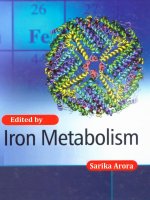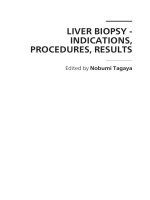Current Concepts in General Thoracic Surgery Edited by Lucio Cagini pptx
Bạn đang xem bản rút gọn của tài liệu. Xem và tải ngay bản đầy đủ của tài liệu tại đây (17.84 MB, 314 trang )
CURRENT CONCEPTS
IN GENERAL
THORACIC SURGERY
Edited by Lucio Cagini
Current Concepts in General Thoracic Surgery
Edited by Lucio Cagini
Contributors
Michele Scialpi, Teresa Pusiol, Irene Piscioli, Alberto Rebonato, Lucio Cagini, Lucio Bellantonio,
Marina Mustica, Francesco Puma, Luca Brunese and Antonio Rotondo, Noritoshi Nishiyama,
Jacopo Vannucci, Cristian Rapicetta, Massimiliano Paci, Tommaso Ricchetti, Sara Tenconi,
Salvatore De Franco and Giorgio Sgarbi, Constance K. Haan, Naohiro Kajiwara, Masatoshi
Kakihana, Jitsuo Usuda, Tatsuo Ohira, Norihiko Kawate and Norihiko Ikeda, Antonio F. Corno,
B. Goslin and R. Hooker, José Francisco Valderrama Marcos, María Teresa González López and
Julio Gutiérrez de Loma, Christodoulos Kaoutzanis, Tiffany N.S. Ballard and Paul S. Cederna,
Slobodan Milisavljević, Marko Spasić and Miloš Arsenijević, Nicolas J. Mouawad, Ajay Gupta,
Hiroshi Makino, Hiroshi Yoshida and Eiji Uchida, Christopher Rolfes, Stephen Howard, Ryan
Goff
and Paul A. Iaizzo
Published by InTech
Janeza Trdine 9, 51000 Rijeka, Croatia
Copyright © 2012 InTech
All chapters are Open Access distributed under the Creative Commons Attribution 3.0 license,
which allows users to download, copy and build upon published articles even for commercial
purposes, as long as the author and publisher are properly credited, which ensures maximum
dissemination and a wider impact of our publications. After this work has been published by
InTech, authors have the right to republish it, in whole or part, in any publication of which they
are the author, and to make other personal use of the work. Any republication, referencing or
personal use of the work must explicitly identify the original source.
Notice
Statements and opinions expressed in the chapters are these of the individual contributors and
not necessarily those of the editors or publisher. No responsibility is accepted for the accuracy
of information contained in the published chapters. The publisher assumes no responsibility for
any damage or injury to persons or property arising out of the use of any materials,
instructions, methods or ideas contained in the book.
Publishing Process Manager Oliver Kurelic
Typesetting InTech Prepress, Novi Sad
Cover InTech Design Team
First published November, 2012
Printed in Croatia
A free online edition of this book is available at www.intechopen.com
Additional hard copies can be obtained from
Current Concepts in General Thoracic Surgery, Edited by Lucio Cagini
p. cm.
ISBN 978-953-51-0870-2
Contents
Preface IX
Chapter 1 Malignant Pulmonary Solitary Nodules:
High Resolution Computed Tomography
Morphologic and Ancillary Features in
the Differentiation of Histotypes 1
Michele Scialpi, Teresa Pusiol, Irene Piscioli,
Alberto Rebonato, Lucio Cagini, Lucio Bellantonio,
Marina Mustica, Francesco Puma,
Luca Brunese and Antonio Rotondo
Chapter 2 Primary Lung Cancer Coexisting with
Lung Metastases from Various Malignancies 15
Noritoshi Nishiyama
Chapter 3 The Acute Stress Reaction to Major Thoracic Surgery 25
Lucio Cagini, Jacopo Vannucci,
Michele Scialpi and Francesco Puma
Chapter 4 Short and Long Term Results of Major
Lung Resections in Very Elderly People 41
Cristian Rapicetta, Massimiliano Paci, Tommaso Ricchetti,
Sara Tenconi, Salvatore De Franco and Giorgio Sgarbi
Chapter 5 Risk Prediction and Outcome Analysis 65
Constance K. Haan
Chapter 6 Robot Assisted Thoracic Surgery (RATS) 89
Naohiro Kajiwara, Masatoshi Kakihana, Jitsuo Usuda,
Tatsuo Ohira, Norihiko Kawate and Norihiko Ikeda
Chapter 7 Valved Conduits Right Ventricle to Pulmonary Artery
for Complex Congenital Heart Defects 101
Antonio F. Corno
Chapter 8 Surgical Management of the Aortic Root 113
B. Goslin and R. Hooker
VI Contents
Chapter 9 Robotic Resection of Left Atrial Myxoma 147
José Francisco Valderrama Marcos,
María Teresa González López and Julio Gutiérrez de Loma
Chapter 10 Thoracic Reconstruction 165
Christodoulos Kaoutzanis, Tiffany N.S. Ballard and Paul S. Cederna
Chapter 11 Thoracic Trauma 197
Slobodan Milisavljević, Marko Spasić and Miloš Arsenijević
Chapter 12 Thoracic Vascular Trauma 239
Nicolas J. Mouawad, Christodoulos Kaoutzanis and Ajay Gupta
Chapter 13 Endoscopic Clipping and Application of Fibrin Glue
for an Esophago-Mediastinal Fistula 263
Hiroshi Makino, Hiroshi Yoshida and Eiji Uchida
Chapter 14 Localized Drug Delivery for Cardiothoracic Surgery 279
Christopher Rolfes, Stephen Howard, Ryan Goff
and Paul A. Iaizzo
Preface
The Aim of “Current Concepts of General Thoracic Surgery” is to provide a brief
overview of several topics in this field. It includes a collection of contributions from
many outstanding Authors who provide their knowledge and experience from many
countries around the world. We apologize for the chapters reviewed that have were
not chosen for publication in this book; however, according to the single centres
experience, the final result offers thorough and precious information on the several
topics evaluated by the Authors. The wide range of subjects discussed goes from CT
assessment of solitary pulmonary and metastatic nodules to prospective studies of
drug delivery in thoracic surgery including surgical risk prediction, stress reaction,
robotic pulmonary and cardiac procedures, vascular and thoracic reconstruction
techniques, thoracic trauma and mediastinal fistula. I believe that this book represents
an enhancement in the knowledge and in the involvement of individuals dedicated to
these areas of study. It is my duty and pleasure to thank colleagues who helped me in
the interesting and stimulating review process; Dr. Stefano Pasquino for cardiac
surgery and Professor Francesco Puma for his many worthwhile suggestions.
Lucio Cagini
Thoracic Surgery Unit, Department of Surgical, Radiologic, and Odontostomatologic
Sciences, University of Perugia, S. Maria della Misericordia Hospital, Perugia,
Italy
Chapter 1
© 2012 Scialpi et al., licensee InTech. This is an open access chapter distributed under the terms of the
Creative Commons Attribution License ( which permits
unrestricted use, distribution, and reproduction in any medium, provided the original work is properly cited.
Malignant Pulmonary Solitary Nodules:
High Resolution Computed Tomography
Morphologic and Ancillary Features
in the Differentiation of Histotypes
Michele Scialpi, Teresa Pusiol, Irene Piscioli, Alberto Rebonato,
Lucio Cagini, Lucio Bellantonio, Marina Mustica, Francesco Puma,
Luca Brunese and Antonio Rotondo
Additional information is available at the end of the chapter
1. Introduction
Solitary pulmonary nodule (SPN) or "coin lesion" is a rounded lesion that does not exceed 3
cm in diameter, completely surrounded by normal lung parenchyma without other
concomitant anomalies (not associated with atelectasis or adenopathy), and often
asymptomatic. Lesions bigger than 3 cm are more properly called masses and are often
malignant [1,2].
SPNs can be found randomly in the course of imaging exams conducted at the level of the neck,
upper limbs, chest, abdomen, and are described in approximately 0.9-2% of all chest X-rays [3].
Since the early 80's the advent of computed tomography (CT) has resulted in a large increase
in the frequency of detection of SPN. In the clinical practice it is important to determine the
radiological and pathological features of benign and malignant tumors for an accurate
management [4-13].
According to the literature the overall prevalence of SPNs ranged between 8% and 51% [14,15].
The American College of Chest Physicians (ACCP) does not recommend the implementation
of screening for lung cancer in the general population because the implementation of these
tests is not so far proved able to achieve a reduction of mortality rates [16].
Because the diagnosis and treatment of early stage lung cancer allows more favourable
results, a close monitoring for identified lesions is recommended [17].
Current Concepts in General Thoracic Surgery
2
A SPN can be attributed to various causes. The first step in the clinical evaluation of these
lesions is to define the benignity or malignancy. The most common benign etiologies include
infectious granulomas and hamartomas, while the most frequent malignant etiologies
include primary lung cancer and lung metastases [2].
The clinical relevance of accurately subtyping lung cancers was initially challenged by the
advent of novel therapeutic options (targeted therapies, such as erlotinib/gefitinib and
bevacizumab, or third-generation chemotherapeutic agents, such as pemetrexed), which are
effective in specific lung cancer subtypes, and needed for a more detailed histological
definition of non-small-cell lung cancer (NSCLC), separating at least squamous-cell
carcinoma (SQC) from non-SQC. This event led pathologists to concentrate their efforts on
the accurate diagnosis of small cell lung carcinoma (SCLC), because further subtyping of
NSCLC was an optional and clinically unimportant diagnostic exercise. The generic
diagnosis of NSCLC gained popularity originally for cytological samples and later
for small biopsies. Currently, on cytological or small biopsy samples, most pathologists are
able to correctly distinguish SCLC from NSCLC, and within the NSCLC group to identify
well-differentiated or moderately differentiated SQC or adenocarcinoma (ADC). [18,19]
However, a high percentage of cases continues to be simply diagnosed as NSCLC, especially
when lacking clear-cut morphologic signs of differentiation. From a practical standpoint, the
call back to histological categorization of NSCLC raises several types of questions. Although
NSCLC subtyping may be relatively easy and feasible on surgical specimens, there are
objective difficulties in examining small biopsies and cytology samples. These techniques
often are the only ones for the final diagnosis of lung cancer, as most patients are not
candidates for radical surgery. When dealing with these small samples, pathologists may be
faced with a higher degree of uncertainty because of the frequent lung tumor heterogeneity
and the higher prevalence of poorly differentiated NSCLC among clinically advanced and
unresectable cases[18,19]. A useful tool to identify squamous or glandular differentiation
and to characterize poorly differentiated NSCLC may be to incorporate ancillary techniques,
such as immunohistochemistry. This approach seems the most promising one, although the
accuracy, sensitivity, and specificity of the diverse immunohistochemical markers remain to
be further defined. Thyroid transcription factor (TTF-1) and/or cytocheratin 7 (CK7) for
ADC and p63 and high-molecular weight cytokeratins (HMWCKs) for SQC are the most
specific and currently validated immunohistochemical markers that may be suitable for
refining most diagnoses even when dealing with quantitatively limited material, such as
cytological samples or small-sized biopsies [20,21]. When the pathologist is not able to
perform a precise histotype diagnosis, the high-resolution computed tomography (HRCT)
may be proposed as further diagnostic approach for determining the lung histotype
maligancies with single polmonary nodule presentation [21].
The aim of our study is to assess whether morphological characteristics of a SPN and
ancillary signs allow to differentiate between the following lung malignancies:
bronchioloalveolar carcinoma (BAC) classified in according to the new criteria, variants of
ADC and SCLC.
Malignant Pulmonary Solitary Nodules: High Resolution
Computed Tomography Morphologic and Ancillary Features in the Differentiation of Histotypes
3
2. Materials and methods
2.1. Patients
From January 2007 to June 2011 we retrospectively reviewed the HRCT examinations of 33
patients (14 females and 19 males) with SPN presentation and histologic diagnosis of SCLC
(n = 5), invasive lepidic ADCs (formerly diagnosed nommucinous BAC with > 5 mm
invasion) (n=7), invasive mucinous ADCs (formerly diagnosed mucinous BAC)(n=2) and
other variants invasive ADCs (acinar, papillary, solid predominant with mucin production,
colloid and enteric variants) (n= 19). SQC, large cell carcinoma, adenosquamous carcinoma
and sarcomatoid carcinoma cases were excluded.
The mean age in the three type of SPNs (SCLC, BACs and ADCs ) were: 60 years ± 6 (SCLC),
67,2 years ±8,2 (BACs) and 71, 3 years ± 8,5 (ADCs) respectively.
2.2. Histological analysis
The histological diagnosis was performed in accordance with the examination of lobectomy in
all cases of ADCs and transbronchial biopsy in 5 SCLC. The classification of ADCs tumors was
performed in accordance with the criteria of International Association for the Study of Lung
Cancer/American Thoracic Society/European Respiratory Society International
Mutlidisciplinary Classification of Lung Adenocarcinoma [22]. The following immunostaining
analysis were performed in all cases of ADCs: TTF1, CK7, P63 and HMWCKs. The
immunostaining of synaptophysin and CD56 was performed in all cases of SCLC.
2.3. HRCT technique
The examinations were performed with three different CT scanners: 16-slices CT (Light
Speed Pro 16, GE, Milwaukee, USA), 16-slices CT (Toshiba Aquilion, Japan) and 64-slices CT
(Philips Medical Systems, Best, the Netherlands) by direct volumetric acquisition with high
spatial resolution CT (HRCT) in a single inspiratory breath with the patient in a supine
position. The technical parameters expected to acquire volumetric reconstruction, are the
following: collimation: 1.0-1.25mm, kV: 135, mA: 300, scan time: 0.7 sec / rotation, table
speed of 17.85 mm / sec. High-spatial-frequency (bone) reconstruction algorithm was used.
Using the axial images the multiplanar reconstructions (MPRs) with high diagnostic quality
were obtained.
2.4. Image analysis
All HRCT images of each SNP were read in consensus by two experienced radiologists
(M.S., A.R.) in chest CT with respect to morphology and ancillary signs. Size ,
margins/countours, calcifications, central necrosis or cavitation and air bronchogram were
evaluated for the morphologic assessment [23]. Furthermore, in association with the
morphological study the following ancillary signs were assessed: pleural connecting striae
and ground glass opacity (GGO).
Current Concepts in General Thoracic Surgery
4
The percentage of ancillary signs and the morphologic appearance were evaluated for the
differential diagnosis.
3. Results
Lesion size ranging from 8 mm to 25 mm (mean 20 mm ±10,4 SD) for SCLC, 15 mm to 30
mm ( mean 22,5 ± 5,7 SD) for BACs , 10 mm to 29mm ( mean 21,2 ± 5,9 SD) for ADCs.
In the table are reported the data related to the morphologic features and to the ancillary
signs with relatives percentages of the three histotype malignant nodules.
Morfologic features: calcifications within the SPN were absent in all case of SCLC and BACs
and found in 1/19 (5,2%) cases of ADCs variants; cavitation was observed in 1/5 (20%) cases
of SCLC; margins/countours (irregular or spiculated, multilobulated, frayed) were revealed
in SCLC, BACs and variants of ADC in 4/5 (80%) 9/9 (100%) 15/19 (79%) and air
bronchogram was revealed in SCLC, BACs and variants of ADC in 2/5 (40%) 5/9 (60%) 8/19
(42%) respectively.
Ancillary signs: air bronchogram and pleural connecting striae were found in SCLC, BACs
and variants of ADC in 2/5 (40%), 5/9 (60%), 8/19 (42%) and 3/5 (80%), 9/9 (100%) 17/19 (89%)
respectively.
The representative HRTC features for the three type of SPNs for SCLC, BACs and variants
of ADC are reported in figures 1,2, figures 3-5 and figures 6-9 respectively.
Figure 1. Small cell lung carcinoma in a 59 year-old man. HRCT shows spiculated and lobulated nodule
with cavitations in the upper left lobe.
Malignant Pulmonary Solitary Nodules: High Resolution
Computed Tomography Morphologic and Ancillary Features in the Differentiation of Histotypes
5
Figure 2. Small cell lung carcinoma in a 69 year-old man.
HRCT shows
spiculated nodule with pleural connecting striae in the ventral segment of the upper right lobe.
HRCT features
SCLC (size ranging
from 8 mm to 25 mm
(mean 20 mm ±10,4 SD)
(n=5)
BAC (size ranging , 15
mm to 30 mm
(mean 22,5 ± 5,7 SD)
(n=9)
ADCs size ranging 10
mm to 29mm
(mean 21,2 ± 5,9 SD)
(n=19)
Calcifications 0/5 (0%) 0/9 (0%) 1/19 (5,2%)
Cavitations 1/5 (20%) 0/9 (0%) 0/19 (0%)
Margins (irregular or
spiculated,
multilobulated)
4/5 (80%) 9/9 (100%) 15/19 (79%)
Air bronchogram 2/5 (40%) 5/9 (60%) 8/19 (42%)
Pleural connecting
striae
3/5 (80%) 9/9 (100%) 17/19 (89%)
Ground-glass opacity 1/5 (20%) 9/10 (90%)* 5/19 (26,3%)
*
In 1 case of invasive mucinous adenocarcinoma (formerly diagnosed mucinous bronchiolo-alveolar carcinomas)
the GGO appearance was not revealed.
Table 1. HRCT morphologic and ancillary of 5 small cell lung carcinomas (SLCL), 7 invasive lepidic
adenocarcinomas (formely diagnosed bronchiolo-alveolar carcinomas pattern, with > 5 mm invasion), 2
invasive mucinous adenocarcinomas (formerly diagnosed mucinous bronchiolo-alveolar carcinomas)
and 19 other variants invasive ADCs (acinar, papillary, solid predominant with mucin production,
colloid and enteric variants).
Current Concepts in General Thoracic Surgery
6
Figure 3. Invasive mucinous adenocarcinoma (formerly diagnosed mucinous bronchiolo-alveolar
carcinoma) in a 74 year-old female.
HRCT shows spiculated nodule with pleural connecting striae in the dorsal segment of the left upper
lobe.
Figure 4. Invasive lepidic adenocarcinoma (formely diagnosed bronchiolo-alveolar carcinoma pattern,
with > 5 mm invasion) in a 75 year-old female. HRCT shows nodule with irregular contours and GGO
in the ventral segment of the left upper lobe .
Malignant Pulmonary Solitary Nodules: High Resolution
Computed Tomography Morphologic and Ancillary Features in the Differentiation of Histotypes
7
Figure 5. Invasive lepidic adenocarcinoma (formely diagnosed bronchiolo-alveolar carcinoma pattern,
with > 5 mm invasion) in a 75 year-old female. HRCT shows lobulated nodule with air bronchogram
and GGO in the left lower lobe.
Figure 6. Invasive variant enteric adenocarcinoma in a 76 year-old man. HRCT shows spiculated
nodule with pleural connecting irregular striae in the dorsal upper right lobe.
Current Concepts in General Thoracic Surgery
8
Figure 7. Invasive variant enteric adenocarcinoma in a 79 year-old man.
HRCT shows spiculated nodule with pleural connecting striae and GGO in the ventral upper righ lobe.
Figure 8. Invasive variant colloid adenocarcinoma in a 64 year-old man.
HRCT shows lobulated spiculated nodule with pleural connecting striae and GGO in the left lower lobe.
Malignant Pulmonary Solitary Nodules: High Resolution
Computed Tomography Morphologic and Ancillary Features in the Differentiation of Histotypes
9
Figure 9. Invasive variant enteric high grade-fetal adenocarcinoma in a 64 year-old man.
HRCT shows spiculated nodule with pleural connecting striae and GGO in the dorsal upper right lobe.
4. Discussion
Adenocarcinoma is the most common histologic subtype of lung cancer in most countries,
accounting for almost half of all lung cancers [24]. A widely divergent clinical, radiologic,
molecular, and pathologic spectrum exists within lung adenocarcinoma. As a result,
confusion exists, and studies are difficult to compare. Despite remarkable advances in
understanding of this tumor in the past decade, remains a need for universally accepted
criteria for adenocarcinoma subtypes, in particular tumors formerly classified as BAC
[18,19].
As the SPN may be the expression of multiple pathologic entities, the incidental finding of
SPN by CT raises the issue of differential diagnosis between benign and malignant nodules.
Moreover the importance of differential diagnosis between malignant histotypes can affect
the prognosis and management of these patients.
A number of terms have been used to describe lung ADC by CT imaging. In particular, for
tumors that present as small nodules, the terms used have reflected the various ground
Current Concepts in General Thoracic Surgery
10
glass (nonsolid), solid, or part-solid appearances that can occur. Largely based on the
Fleischner Society glossary of terms [21] and the recently suggested guidelines by Godoy
and Naidich [25] for subsolid nodules, we propose the following definitions: (1) a pure
ground-glass nodule (GGN) (synonym: nonsolid nodule) as a focal area of increased lung
attenuation within which the margins of any normal structures, e.g., vessels, remain
outlined, (2) a solid nodule as a focal area of increased attenuation of such density that
any normal structures, e.g., vessels, are completely obscured, and (3) part solid nodule
(synonym: semisolid nodule) as a focal nodular opacity containing both solid and ground-
glass components [21,25]. The Fleischner Society glossary of terms for thoracic imaging
defines a nodule on a CT scan as “a rounded or irregular opacity, well or poorly defined,
measuring up to 3 cm in greatest diameter” in any plane [21]. If the opacity is greater
than 3 cm, it is referred to as a mass [21]. The 3 cm cut-off is in keeping with our concept
of the maximum accepted size for the pathologic diagnosis of AIS and MIA. The term
subsolid nodule has also entered common radiologic usage, referring to both part-solid
nodules and a pure GGN [25]. Optimal evaluation of subsolid nodules requires thin-
section CT scans (<3 mm thickness) to assess the solid versus ground-glass components
[20,21].
The aim of our study is to assess the morphologic and ancillary HRCT features of the
histotypes of malignant SPNs considering that often histological and/or cytological material
may be unsatisfactory and immunoistochemical techniques may be not performed.
In our study the calcifications within the SPN were absent in all cases of SCLC and BACs
and found in one case of ADCs.
The margins were irregular or spiculated, multilobulated in 4/5 (80%) of SCLC, in 9/9 (100%)
of cases previously diagnosed as BACs, and in 15/19 (79%) of other variants of ADCs.
The opacity-like bullous, a sign of the presence of air bronchogram, does not help us in
making any differential diagnosis, being present in 40% (2/5) of SCLC in 42% (8/19) of
variants of ADCs and in 60% (5/9) of formerly diagnosed BACs. The occurrence of
cavitations, expression of the speed of growth of the tumor cell and indicative of the
presence of necrosis [26,27], was detected only in one aggressive forms of SCLC (20%). In all
cases of all variants of ADCs and in cases previously diagnosed as BACs the cavitations
were absent.
The SPN may be connected to the pleura by striae or streaks defined as linear density that
extends to the pleura and were the result of a fibrosis in the pulmonary peripheral lung. The
striae connecting pleura or pleural effusion tags are found with high frequency in the three
tumor subtypes, ranking as a sign that directs us to a differential diagnosis of malignancy
without giving specific indications about the histotype tumor (80% SCLC, 89% variants of
ADCs, 100% formerly diagnosed BACs).
The ground glass perinodular opacity were areas of increased attenuation of hazy lung with
preservation of bronchial and vascular margins [29] and intranodular air bronchogram
Malignant Pulmonary Solitary Nodules: High Resolution
Computed Tomography Morphologic and Ancillary Features in the Differentiation of Histotypes
11
were the result of asymptomatic growth with the larger bronchi free of malignancies. The
ground glass opacity (GGO) instead is significantly more present in the lesions slower
growing and less invasive locoregional (26,3 % variants of ADCs and 90% formerly
diagnosed BACs) than lesions infiltrative rapidly (only 20% of SCLC).
In conclusion, ancillary signs (pleural striae and GGO) in association with air bronchogram
are suggestive of diagnosis of the invasive lepidic ADCs (formerly diagnosed nommucinous
BAC with > 5 mm invasion) and can be considered in the differential diagnosis of malignat
SNPs histotypes ( SCLC and ADCs)
Author details
Michele Scialpi, Alberto Rebonato, Lucio Bellantonio and Marina Mustica
Department of Surgical, Radiologic, and Odontostomatologic Sciences, Complex Structure of
Radiology 2, University of Perugia, S. Maria della Misericordia Hospital, S. Andrea delle Fratte,
Perugia, Italy
Teresa Pusiol
Institute of Anatomic Pathology, S. Maria del Carmine Hospital, Rovereto (Trento), Italy
Irene Piscioli
Institute of Radiology, Budrio Hospital, Bologna, Italy
Lucio Cagini and Francesco Puma
Department of Surgical, Radiologic, and Odontostomatologic Sciences, Thoracic Surgery
Unit, University of Perugia, S. Maria della Misericordia Hospital, S. Andrea delle Fratte,
Perugia, Italy
Luca Brunese
Department of Health Science, University of Molise, Campobasso, Italy
Antonio Rotondo
Department of Clinical and Experimental Medicine and Surgery “F. Magrassi,” University of
Naples, Naples, Italy
5. References
[1] Tuddenham Wj: Glossary of terms for thoracic radiology: recommendations of
Nomenclature Committee of Fleischner Society - AJR 1984; 143(3):509-517.
[2] Ross H. Albert, John J. Russell: La valutazione di un nodulo solitario del polmone -
Minuti Sett. 2010 Anno XXXIV - n.8.
[3] Holin S.N., Dwork R.E., Glaser S., et al.: Solitary pulmonary nodules found in a
community-wide chest roentgenographic survey - Am Tuberc Pulm Dis. 1959; 79:427-
439.
Current Concepts in General Thoracic Surgery
12
[4] Bartolotta TV, Midiri M, Scialpi M, Sciarrino E, Galia M, Lagalla R. Focal nodular
hyperplasia in normal and fatty liver: a qualitative and quantitative evaluation with
contrast-enhanced ultrasound. Eur Radiol. 2004 Apr;14(4):583-91.
[5] Scialpi M, Pierotti L, Piscioli I, Brunese L, Rotondo A, Yoon SH, Lee JM. Detection of
small (<=20 mm) pancreatic adenocarcinoma: histologic grading and CT enhancement
features. Radiology. 2012;262(3):1044.
[6] Brancato B, Crocetti E, Bianchi S, Catarzi S, Risso GG, Bulgaresi P, Piscioli F, Scialpi M,
Ciatto S, Houssami N. Accuracy of needle biopsy of breast lesions visible on
ultrasound: audit of fine needle versus core needle biopsy in 3233 consecutive
samplings with ascertained outcomes. Breast. 2012;21(4):449-54.
[7] Tranfaglia C, Cardinali L, Gattucci M, Scialpi M, Ferolla P, Sinzinger H, Palumbo B
(111)in-pentetreotide spet/ct in carcinoid tumours: is the role of hybrid systems
advantageous in abdominal or thoracic lesions? Hell J Nucl Med. 2011;14(3):274-7.
[8] Pusiol T, Zorzi MG, Morichetti D, Piscioli I, Scialpi M. Uselessness of radiological
differentiation of oncocytoma and renal cell carcinoma in management of small renal
masses. World J Urol. 2011 May 21.
[9] Brancato B, Scialpi M, Pusiol T, Zorzi MG, Morichetti D, Piscioli F. Needle core biopsy
should replace fine needle aspiration cytology in ultrasound-guided sampling of breast
lesions. Pathologica. 2011;103(2):52.
[10] Pusiol T, Zorzi MG, Morichetti D, Piscioli I, Scialpi M. Uselessness of percutaneous
core needle renal biopsy in the management of small renal masses. Urol Int.
2011;87(1):125-6.
[11] Pusiol T, Zorzi MG, Morichetti D, Piscioli I, Scialpi M. Uselessness of percutaneous
core needle renal biopsy in the management of small renal masses. Urol Int.
2011;87(1):125-6.
[12] Pusiol T, Zorzi MG, Morichetti G, Piscioli I, Scialpi M. Synchronous nonfunctional
duodenal carcinoid and high risk gastrointestinal stromal tumour (GIST) of the
stomach. Eur Rev Med Pharmacol Sci. 2011;15(5):583-5.
[13] Pusiol T, Franceschetti I, Scialpi M, Piscioli I, Sassi C, Parolari AM. Incidental
Necrotizing Paratubal Granuloma Associated with Multiple Neoplasms. J. Gynecol Surg.
2011, 27(1): 29-32.
[14] Gohagan J., Marcus P., Fagerstrom R., et al.: Baseline findings of a randomized
feasibility trial of lung cancer screening with spiral CT scan vs chest radiograph: the
Lung Screening Study of National Cancer Institute - Chest. 2004;126(1):114-121.
[15] Swensen S.J., Jett J.R., Hartman T.E., Midthun DE, Sloan JA, Sykes AM, Aughenbaugh
GL, Clemens MA: Lung cancer screening with CT: Mayo Clinic experience - Radiology.
2003; 226(3):756-761.
[16] Bach P.B., Silvestri G.A., Hanger M, Jett JR., for the American College of Chest
Physicians: Screening for lung cancer: ACCP evidence-based clinical practice guidelines
- 2nd ed. Chest 2007; 132(3 suppl):69S-77S.
Malignant Pulmonary Solitary Nodules: High Resolution
Computed Tomography Morphologic and Ancillary Features in the Differentiation of Histotypes
13
[17] Steele J.D.: The solitary pulmonary nodule. Report of a cooperative study of resected
asymptomatic solitary pulmonary nodules in male - J Thorac Cardiovasc Surg. 1963;46:21-
39.
[18] World Health Organisation Classification of Tumours, Pathology & Genetics, Tumours
of the Lung, Pleura, Thymus and Heart. Edited by Travis WD, Brambilla E, Muller-
Hermelink HK, Harris CC. Lyon, France: IARC Press, 2004.
[19] Travis WD, Colby TV, Corrin B, et al. Histological Typing of Lung and Pleural Tumors.
Berlin: Springer, 1999.
[20] Lee HY, Goo JM, Lee HJ, et al. Usefulness of concurrent reading using thin-section and
thick-section CT images in subcentimetre solitary pulmonary nodules. Clin Radiol
2009;64:127–132.
[21] Hansell DM, Bankier AA, MacMahon H, et al. Fleischner Society: glossary of terms for
thoracic imaging. Radiology 2008;246:697–722.
[22] Travis WD, Brambilla E, Noguchi M, Nicholson AG, Geisinger KR, Yatabe Y, Beer DG,
Powell CA, Riely GJ, Van Schil PE, Garg K, Austin JH, Asamura H, Rusch VW, Hirsch
FR, Scagliotti G, Mitsudomi T, Huber RM, Ishikawa Y, Jett J, Sanchez-Cespedes M,
Sculier JP, Takahashi T, Tsuboi M, Vansteenkiste J, Wistuba I, Yang PC, Aberle D,
Brambilla C, Flieder D, Franklin W, Gazdar A, Gould M, Hasleton P, Henderson D,
Johnson B, Johnson D, Kerr K, Kuriyama K, Lee JS, Miller VA, Petersen I, Roggli V,
Rosell R, Saijo N, Thunnissen E, Tsao M, Yankelewitz D. International Association for
the Study of Lung Cancer/American Thoracic Society/European Respiratory Society
International Multidisciplinary Classification of Lung Adenocarcinoma. J Thorac Oncol.
2011;6(2):244-85.
[23] Travis WD, Linnoila RI, Tsokos MG, Hitchcock CL, Cutler GB Jr, Nieman L, Chrousos
G, Pass H, Doppman J, Neuroendocrine tumors of the lung with proposed criteria for
large-cell neuroendocrine carcinoma. An ultrastructural, immunohistochemical, and
flow cytometric study of 35 cases. Am J Surg Pathol. 1991;15(6):529-53.
[24] Curado MP, Edwards B, Shin HR, et al. Cancer Incidence in Five Continents, Vol. IX.
Lyon: IARC Scientific Publications, 2007.
[25] Godoy MC, Naidich DP. Subsolid pulmonary nodules and the spectrum of peripheral
adenocarcinomas of the lung: recommended interim guidelines for assessment and
management. Radiology 2009;253:606– 622.
[26] Pentheroudakis G, Kostadima L, Fountzilas G, Kalogera-Fountzila A, Klouvas G,
Kalofonos C, Pavlidis N. Cavitating squamous cell lung carcinoma-distinct entity or
not? Analysis of radiologic, histologic, and clinical features. Lung Cancer 2004;45:349–
355.
[27] Onn A, Choe DH, Herbst RS, Correa AM, Munden RF, Truong MT, Vaporciyan AA,
Isobe T, Gilcrease MZ, Marom EM. Tumor cavitation in stage I non-small cell lung
cancer: epidermal growth factor receptor expression and prediction of poor outcome.
Radiology 2005;237:342–347.
Current Concepts in General Thoracic Surgery
14
[28] Travis WD, Garg K, Franklin WA, Wistuba II, et al. Evolving concepts in the pathology
and computed tomography imaging of the lung adenocarcinoma and
bronchioloalveolar carcinoma. J Clin Oncol 2005; 23: 3279-87.
Chapter 2
© 2012 Nishiyama, licensee InTech. This is an open access chapter distributed under the terms of the
Creative Commons Attribution License ( which permits
unrestricted use, distribution, and reproduction in any medium, provided the original work is properly cited.
Primary Lung Cancer Coexisting with
Lung Metastases from Various Malignancies
Noritoshi Nishiyama
Additional information is available at the end of the chapter
1. Introduction
Various tumors metastasize to the lung, and they are often detected as multiple nodules.
Advances in computed tomography (CT) have made it possible to detect small tumors. Even
for multiple pulmonary nodules with previous malignancy, surgical removal is often
required when the primary sites are well controlled and no other sites are involved.
However, preoperative differential diagnosis of coexisting primary lung cancer is usually
difficult for such small nodules [1].
Here, three cases of lung metastases that coexisted with primary lung cancer, confirmed by
postoperative histological examination, are presented. In addition, a case with a proven lung
cancer that coexisted with small nodules in the ipsilateral lung, one of which was
pathologically diagnosed as a metastasis from rectal cancer, is presented. Further, the
importance of active tissue diagnosis including surgery is discussed.
2. A: Lung metastases from various malignancies coexisting with primary
lung cancer
2.1. Case 1
A 53-year old woman was diagnosed by needle biopsy as having a myxoid liposarcoma in
the right thigh. A chest CT scan revealed small bilateral pulmonary nodules, which were
diagnosed as pulmonary metastases; and the patient underwent two courses of
preoperative chemotherapy with ifosfamide and adriamycin. There was a partial response
to the chemotherapy for both the primary tumor and pulmonary metastases. Surgical
resection of the primary tumor in the right thigh and bilateral pulmonary metastasectomy
via sequential small axillary thoracotomies under video assistance (one in the right lower









